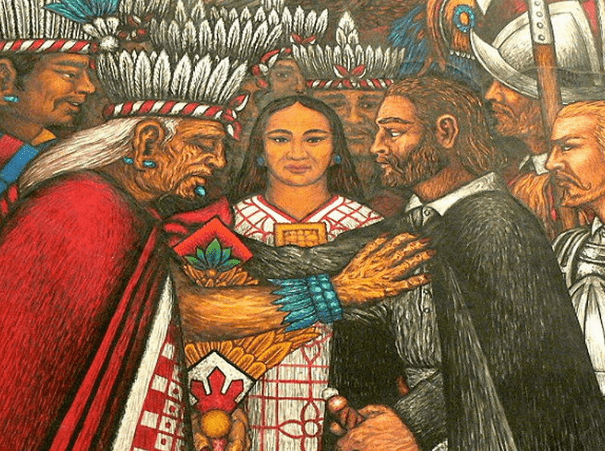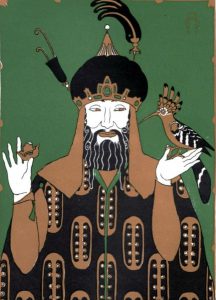Winner of the Fall 2016 StMU History Media Award for
Best Article in the Category of “People”
Best Article in the Category of “World History”
Largely due to the importation of disease and use of superior weapons, the Spaniards were able to conquer the Aztec capital of Tenochtitlan, kill the empire’s last emperor, Cuauhtémoc, and bring the Aztec empire to an end. Few know of La Malinche, the indigenous interpreter of Hernán Cortés, whose linguistic abilities were used to facilitate important conversations between the Spaniards and the indigenous leaders. Without the help of La Malinche, perhaps the Aztec empire would have survived.
Born between 1502 and 1505, La Malinche was named Malinalli Tenepal, the first part of her name being a Nahuatl term for the twelfth day of the month in correspondence to the Aztec calendar, and the second part of her name meaning “lively.” She was born of nobility in Paynala within the region of Veracruz. Her troubles started at a young age after the death of her father. La Malinche was ousted from her home to ensure her new half-brother received the inheritance of the family instead of her, since she was the eldest child. She was given to “some Indians of Xicalango.”1 Then the Indians gave her to a nobleman in Tobasco, a region in the Yucatan. When Cortés arrived to Tobasco, he was offered twenty slaves, one of them being La Malinche. Having lived in Veracruz, a Nahuatl-speaking region, and then being sold into a Maya-speaking region, La Malinche knew both languages and she was soon recognized for the linguistic talents that could benefit Cortés in his conquests.2

The few glimpses of La Malinche and how her presence as an interpreter accelerated the fall of the Aztec empire can be found in the writings of the Spanish explorers, specifically from Hernán Cortés, her “lord and master.”3 From the second letter Hernán Cortés wrote to Emperor Charles V, dated October 30, 1530, Cortés speaks of La Malinche as “a female interpreter that I had, who was a native of this country, and whom I obtained at Putunchún on the Rio Grande.”4 This confirms the vague aspects of her life that we already know. But most importantly, in this context, this letter goes on to tell of a scenario in which La Malinche saved the Spaniards from an ambush by the Cholulans. La Malinche was told by the wife of a native leader that they planned to attack the Spaniards and if La Malinche came with them, she would be protected. La Malinche delivered this message to Cortés, which ultimately led to the massacre of Cholula and provided a direct path to march towards Tenochitlan, the capital of the Aztec empire.5 This leads to the question of whether or not La Malinche was a traitor or a survivor. Did she explicitly want the Aztec empire to fall or did she just want to save herself from the carnage?
With no traces of primary sources from La Malinche herself, her story has been retold by various scholars without much consistency, nothing ever being certain. Up until the twentieth century, La Malinche was viewed as a traitor to her country Mexico. In 1861, on the celebration day of Mexico’s Independence, Ignacio “El Nigromante” Ramírez, a Mexican journalist, addressed the Mexican people by saying, “One of the mysteries of fate is that every Mexican owes his downfall and disgrace to a woman, and to another woman his salvation and glory; the myth of Eve and Mary is reproduced everywhere; we indignantly remember Cortés’s mistress and will never forget, in our gratitude to Doña María Josefa Ortiz.”6 La Malinche is seen as playing a key role in the subjugation of the Mexican peoples to Spain, while Doña María Josefa Ortiz did the contrary and liberated the country. However, many Chicana writers and modern scholars are trying to rewrite the tale of La Malinche to understand the complexities of her choices and to vindicate her. For example, Gloria Anzaldua promotes the idea that La Malinche had a “new consciousness,” that she voluntarily served as the interpreter of Cortés not only to save herself, but also because she knew that a new mestiza culture was going to be born (especially considering she had a son with Cortés in 1524).7 She made a conscious effort to exchange language and cultural aspects from each side in order to facilitate the emergence of the new mestiza society; however, with that came brutal consequences in the shape of warfare and mass death in the New World.
Whether or not La Malinche’s role as Cortés’s interpreter was traitorous, simply an effort to survive, or some other complex reason involving love for Cortés, hate for the Aztec empire for the cruelty she faced after being ousted from her home, or promotion of the new mestiza culture, no one will ever know the true story of the Indian, slave woman who traveled alongside Cortés towards the culmination of the Aztec empire.
- Bernal Castillo del Díaz, The Discovery and Conquest of Mexico, 1517-1521 rev. American ed., trans. A.P. Maudsley (New York: The Noonday Press, 1965), chap. 22-23. ↵
- Pilar Godayol, “Malintzin/ La Malinche/ Doña Marina: re-reading the myth of the treacherous translator,” Journal of Iberian and Latin American Studies 18, no. 1 (April 2012): 61-68. ↵
- Castillo del Bernal, chap 23. ↵
- Hernan Cortes to Emperor Charles V, October 30, 1520, in Letters of Despatches of Hernando Cortes, to the Emperor Charles V., trans. (New York: Wiley and Putnam, 1843), letter II. ↵
- Hernan Cortes to Emperor Charles V, October 30, 1520, in Letters of Despatches of Hernando Cortes, to the Emperor Charles V, letter II. ↵
- Rosario Pérez-Lagunes, “The Myth of La Malinche: From the Chronicles to Modern Mexican Theater” (PhD dis., Virginia Polytechnic Institute and State University, 2001), 24. Although she was of Spanish descent, Doña María Josefa Ortiz was born in Valladolid, Mexico in 1768 and identified herself as Mexican. She and her husband were both a part of the rebellion that ultimately led to Mexico’s independence from Spain in 1824. ↵
- Godayol, 68-70. ↵



230 comments
Jake Faryniarz
This article was very interesting about how the Spaniards received help that led them to defeat the Aztec Empire. La Maliche was seen by some as a traitor and by others a survivor. I believe she should be considered a survivor because she was ousted from her home so she wouldn’t receive the throne and also put into slavery. Her society mistreated her and so all she knew what to do was survive. So she helped the Spaniards in order to be protected from the carnage. This was a well informed article and it gave me more knowledge about the Spanish conquest in Mexico.
Franchesca Baldwin
This was written and explained so well. I wish more could be known about her life, but I understand somewhat of why she did what she did. Aztec culture had not been kind to her at times, and the idea of her being not only accepted but valued as a part of Cortes’s crew would make it easy to double guess your allegiance.
Mia Hernandez
I had never heard about La Malinche before reading this article, but I enjoyed reading about her. I have conflicted feelings over her actions and I can not decide if she is a traitor or survivor. If I had to choose, I would say that she should be remembered as both a traitor in Latin American history because her actions did betray her people in order to save herself. It was a fascinating story and I loved how detailed it was.
Justine Ruiz
I enjoyed reading this article very much! I have never heard of La Malinche before yet alone know how big of a role she played. When reading this article, I begin to question whether she was a traitor or survivor. There’s always two sides to a story and we may never actually know her side. I personally believe that she was a survivor, but how she went about it was very wrong. `
Keily Hart
This was a very well written and interesting article. I did not know who La Malinche was before I read this article, but she has a super interesting story even if it is incomplete. I think that calling her a traitor is a bit excessive, though what she did was by no means selfless. She was really just a girl doing her best not to get murdered.
Carlos Serna
I love to learn about the stories of how the Spanish conquer almost all of America. I found the story of La Malinche so fascinating. I can understand the reason why she was at the side of the Spanish. She got a difficult life being a woman in a man-based society. She was offered as a slave and was always traded. But, deeper inside me I feel that she is a traitor because she gave her people in change of living. I would prefer dying by protecting the land that saw me born than living as the dog of strangers.
Maria Cossio
This was an awesome article. It was very well explained and with great details. Before reading this article, I had never heard about La Malinche’s story and how she influenced a very important event in history. It is impressive how there are so many untold stories about different events in time but people only mention the bigger and most important events. However, there are small stories that end up being told but sometimes there is not enough information about it. So, I’m glad and appreciate how deeply you have investigated the subject and how much information and knowledge you’ve gained. Thanks to you, I’m sure that many others will be able to read this article and also get to know more about La Malinche. This was a great article and I really enjoyed learning new information about world history.
Reba Reyes
I have never heard of La Malinche till this article but it does spark up some questions for me to ask if whether she was a traitor or survivor. Both sides had some very strong, valid reasons. This article was very well played out and kept me hooked on the situation till the very end. I really enjoyed reading it also because it gave me two sides of the story which can make you think about it a but more.
Abilene Solano
This article really made me think more about how I viewed La Malinche because growing up I was taught that she was a traitor to her country yet after reading this article I realized that there could be two sides of La Malinche’s story that we may not know about. We already don’t know much about this native woman but we fail to realize that what she did was just the means to survive. She probably knew what the Spanish conquistadors were going to do so instead of resisting them, she was willing to sacrifice her people just so that she could survive and live another day. Overall, this was a great article and I really liked how the author really made you think about both sides of the story about La Malinche.
Janaya Felder
Although she efforts to make peace, it’s sad to see how those efforts seemed to help in the downfall of the Aztecs. However she did what she had to do to survive which is notable. This article did a great job of showing both sides. I really enjoyed it!